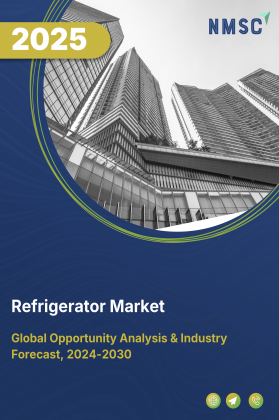
Heating Equipment Market by Product (Heat Pumps, Furnaces, Boilers, Unitary Heaters, and Others), by Propulsion Type (Natural Gas, Oil, Electricity, Biomass, Solar energy and Others), by Application (Space Heating, Water Heating, Air Heating and Industrial Process Heating), by End Users (Residential, Commercial and Industrial) – Global Opportunity Analysis and Industry Forecast 2024-2030
Market Definition
The Heating Equipment Market size was valued at USD 48.3 billion in 2023 and is predicted to reach USD 66.17 billion by 2030 with a CAGR of 4.6% from 2024-2030.
Heating equipment is an appliance or system designed to generate heat for various purposes such as space heating, water heating, or processing materials in industrial settings. It utilizes diverse methods for generating heat, including combustion of fuels, resistance to electricity, and harnessing heat transfer from external sources such as solar or geothermal energy. Heating equipment’s ability to adapt to different power sources and technologies enhances its applicability and makes it an essential component for comfortable living and working environments. Additionally, heating equipment reduces energy costs by efficiently generating and distributing heat, minimizing waste and maximizing energy usage by improving efficiency and integrating renewable energy sources.
Market Dynamics and Trends
The increasing environmental concerns among consumers increases demand for technologies that reduce energy consumption. With climate change looming large and air pollution posing significant health risks, governments and consumers are increasingly prioritizing environmentally friendly heating solutions. The International Energy Agency published a report in 2023, which highlighted heat pump’s key role in providing secure and sustainable heating worldwide.
By using low-emissions electricity, 10% of global space heating needs were met in 2021 and have the potential to reduce CO2 emissions by 500 billion tonnes by 2030.The integration of energy-efficient heating equipment significantly reduces operating costs and environmental impact by using less energy to generate the same amount of heat, thereby propelling the growth of the market.
Moreover, the rapid growth of manufacturing industries serves as a significant driver for the expansion of the heating equipment market. According to the World Manufacturing Foundation report of 2022, the manufacturing sector plays a pivotal role in driving economic growth, contributing approximately 17% to global GDP and acting as a catalyst for demand in various other industries. As manufacturing activities surge, there is a parallel increase in the need for heating equipment to maintain optimal working conditions within industrial facilities.
Furthermore, technological advancements and innovations in heating equipment are driving market expansion, continually shaping the industry landscape and meeting evolving consumer demands. Innovations such as condensing boilers, heat pumps with variable-speed compressors, and advanced control systems allow for higher energy efficiency and reduced operating costs.
These technologies not only lower energy consumption but also contribute to environmental sustainability by reducing carbon emissions and reliance on fossil fuels. Additionally, energy-efficient heating systems such as smart thermostats, and renewable energy-based heating technologies are gaining progress as consumers and industries prioritize sustainability and cost-effectiveness.
For instance, in July 2022, Universal Electronics Inc. launched smart thermostat that aims to provide thermostat to manage through the RUCKUS IoT suite for hospitality and offers sustainable energy features, enabling property managers and hoteliers to save costs and energy in occupied units.
However, stringent regulatory strategies in the heating equipment industry necessitate specific standards for energy efficiency, emissions, and safety, necessitating costly equipment upgrades or modifications to ensure compliance. The financial burden of meeting these requirements presents obstacles for manufacturers and users, thereby restraining the market growth.
On the contrary, the integration of smart home technology represents a shifting paradigm that is expected to advance significantly in the coming years. As this trend continues to evolve, it becomes imperative for heating systems installed in these homes to seamlessly integrate with various devices. This integration enables remote monitoring and temperature adjustments, enhancing comfort and energy efficiency for users, this advancement will create an ample growth of the market in forthcoming years.
Market Segmentations and Scope of the Study
The heating equipment market is segmented on the basis of product, propulsion type, application, end user, and region. On the basis of product, heat pumps, furnaces, boilers, unitary heaters, and others. Based on propulsion type, the market is segregated into natural gas, oil, electricity, biomass, solar energy and others. Based on application, the market is segmented into space heating, water heating, air heating and industrial process heating. Based on end-user, the market is segmented into residential, commercial, and industrial. Regional breakdown and analysis of each of the aforesaid segments includes regions comprising of North America, Europe, Asia-Pacific, and Rest of World (Row).
Geographical Analysis
North America holds the major share of the heating equipment market and is projected to maintain its dominance throughout the forecast period. The rapid growth of refineries in North America, particularly in the United States, serves as a significant driver for the expansion of the heating equipment market in the region.
According to the U.S. Energy Information Administration report of 2023, there are 129 operable refineries in the U.S., highlighting the substantial presence of this critical infrastructure. The increased presence of refineries necessitates heating equipment for crucial processes like distillation, cracking, reforming, and desulfurization. Additionally, as new refinery projects are commissioned and existing facilities undergo upgrades and expansions, there is a surge in demand for heating equipment and related services, including design, installation, and maintenance.
Moreover, government initiatives promoting energy efficiency play a significant role in driving the market growth in the region. With the regulation of various mechanisms such as rebates, tax incentives, and regulatory mandates adopted by the government in this region, encourages homeowners to transition towards advanced, energy-efficient heating systems.
According to Internal Revenue Service report of 2023, homebuyers in the U.S. can claim a tax credit of around 30% for purchasing a property with qualified heat pumps installed, whether in an existing residence or a newly constructed one. Government initiatives that promote energy efficiency and provide incentives are driving a trend towards the adoption of advanced energy-efficient heating systems among residential users.
On the other hand, Asia Pacific is expected to show a steady rise in the heating equipment market owing to the rapid growth of petrochemical industries in developing nations such as India and China. According to report of the Indian Ministry of Chemical and Fertilizer in 2023, India’s chemical and petrochemical (CPC) industry holds a significant position in the global market, worth USD 178 billion, and is expected to reach about USD 300 billion by 2025. This significant growth rate in the industry propels the usage of heating systems for various industrial tasks, boosting the growth of the market in this region.
Moreover, with rapid urbanization in this region, an increasing number of individuals are migrating to cities. According to United Nations Conference on Trade and Development report of 2023, over the last ten years, urbanization has been most pronounced in the developing countries in Asia that saw the urban rate increase from 44.0% in 2012 to 50.6% in 2022. This trend has heightened the demand for various types of buildings, including residential, commercial, and industrial structures, all of which necessitate heating systems for both comfort and functionality purposes, thereby propelling market growth.
Competitive Landscape
Various market players operating in the heating equipment market includes Daikin Industries Ltd., Lennox International Inc., Klima-Therm, Johnson Controls International plc, Robert Bosch GmbH, Viessmann Werke GmbH & Co. KG, Mitsubishi Electric Corporation, Nortek Global HVAC LLC, Rheem Manufacturing Company, A.O. Smith Corporation. and others. These market players are adopting various strategies such as collaboration, acquisition and product launches to remain dominant in the market. For instance, in January 2024, Daikin industries acquired British service company Robert Heath Heating Ltd. The acquisition aims to strengthen Daikin’s residential heating service network in the UK by catering to the growing customer base of residential heat pump installations, fostering mutual growth, and guaranteeing customer satisfaction.
Moreover, in September 2023, Johnson Controls launched the Hitachi air365 Hybrid dual fuel system which combines a heat pump and furnace. The product incorporates a mini heat pump for primary heating and cooling with dual fuel module, and reduces the carbon emission.
Furthermore, in February 2023, Daikin and Greater Manchester collaborated to retrofit homes and foster innovation. This collaboration seeks to address sustainability challenges by enhancing energy efficiency and reducing carbon emissions across residential properties by including the installation of advanced heating and cooling systems,
Key Benefits
-
The report provides quantitative analysis and estimations of the heating equipment market from 2024 to 2030, which assists in identifying the prevailing market opportunities.
-
The study comprises a deep-dive analysis of heating equipment market including the current and future trends to depict prevalent investment pockets in the market.
-
Information related to key drivers, restraints, and opportunities and their impact on the heating equipment market is provided in the report.
-
Competitive analysis of the players, along with their market share is provided in the report.
-
SWOT analysis and Porters Five Forces model is elaborated in the study.
-
Value chain analysis in the market study provides a clear picture of roles of stakeholders.
Key Market Segments
By Product
-
Heat Pumps
-
Furnaces
-
Boilers
-
Unitary Heaters
-
Others
By Propulsion Type
-
Natural Gas
-
Oil
-
Electricity
-
Biomass
-
Solar energy
-
Others
By Application
-
Space Heating
-
Water Heating
-
Air Heating
-
Industrial Process Heating
By End User
-
Residential
-
Commercial
-
Industrial
By Region
-
North America
-
The U.S.
-
Canada
-
Mexico
-
-
Europe
-
The U.K.
-
Germany
-
France
-
Italy
-
Spain
-
Denmark
-
Netherlands
-
Finland
-
Sweden
-
Norway
-
Russia
-
Rest of Europe
-
-
Asia-Pacific
-
China
-
Japan
-
India
-
South Korea
-
Australia
-
Indonesia
-
Singapore
-
Taiwan
-
Thailand
-
Rest of Asia-Pacific
-
-
Rest of the World (RoW)
-
Latin America
-
Middle East
-
Africa
-
REPORT SCOPE AND SEGMENTATION:
|
Parameters |
Details |
|
Market Size in 2023 |
USD 48.3 billion |
|
Revenue Forecast in 2030 |
USD 66.17 billion |
|
Growth Rate |
CAGR of 4.6% 2024 to 2030 |
|
Analysis Period |
2023–2030 |
|
Base Year Considered |
2023 |
|
Forecast Period |
2024–2030 |
|
Market Size Estimation |
Billion (USD) |
|
Growth Factors |
|
|
Countries Covered |
28 |
|
Companies Profiled |
10 |
|
Market Share |
Available for 10 companies |
|
Customization Scope |
Free customization (equivalent to up to 80 working hours of analysts) after purchase. Addition or alteration to country, regional, and segment scope. |
|
Pricing and Purchase Options |
Avail customized purchase options to meet your exact research needs. |
KEY PLAYERS
-
Daikin Industries Ltd.
-
Lennox International Inc.
-
Klima-Therm
-
Johnson Controls International plc
-
Robert Bosch GmbH
-
Viessmann Werke GmbH & Co. KG
-
Mitsubishi Electric Corporation
-
Nortek Global HVAC LLC
-
Rheem Manufacturing Company
-
A.O. Smith Corporation




















 Speak to Our Analyst
Speak to Our Analyst

























